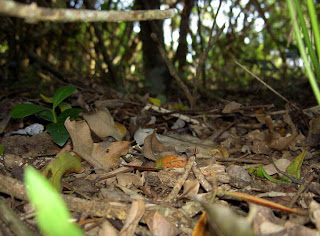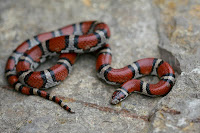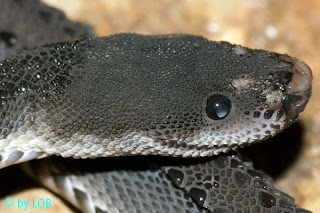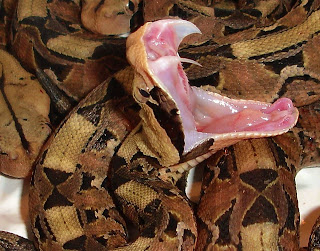A while back, medical-doctor-turned-snake-blog-post-translator-extraordinaire
1 Alvaro Permartin asked me to write an article covering basic snake taxonomy. Taxonomy is the branch of biology that deals with
naming and classifying organisms. Biologists still use the
Linnean hierarchical system for taxonomy, which is convenient for grouping organisms, but there is a move towards using
phylogenetic systematics and
the evolutionary species concept in taxonomy, particularly in the sense that recognizing and giving names to non-monophyletic groups is discouraged.
2 We'll primarily stick with the Linnean system in this article, which uses particular suffixes to denote the taxonomic level (for example, all animal families end in
'-idae' and all subfamilies end in
'-inae'). However, I've also included some
cladograms, which are the most useful figures for understanding evolutionary relationships. If you haven't read one before, you can read up on them
here,
here, or
here, but just know that they essentially work just like a family tree.
Snake Diversity![]() |
My sole criticism of this film:
not enough snakes |
There are about 3,400 species of snakes in the world. All are placed in the suborder Serpentes (aka Ophidia) of the order Squamata, which also includes lizards, from which snakes evolved about 190 million years ago during the Jurassic Period.
Extant (modern or living) snakes are divided into two major groups, the blindsnakes (aka threadsnakes or
scolecophidians) and the advanced or true snakes (
alethinophidians). Advanced snakes are also divided into two non-monophyletic groups, the "older snakes" (
henophidians) and the "recent snakes" (
caenophidians). The vast majority of all living snakes, about 77% or 2,650 species, are caenophidians, including most of the snakes you've probably heard of: rattlesnakes, cobras, kingsnakes, and many others. A few well-known snakes are henophidians, namely boas and pythons. Most scolecophidians are poorly known. Let's break down each of these groups in slightly more detail.
ScolecophidiansThere are about 400 species of scolecophidians, divided into five families and found mostly in the tropics. They are commonly called blindsnakes, because many have vestigial eyes as a result of their fossorial lifestyle, or threadsnakes, because most are very thin. Most have unspecialized ventral scales, shed in thick rubbery rings, and have a spine at their tail tip. Many eat termites and ants. Most are probably oviparous, or egg-laying, but their reproductive biology is poorly known. Scolecophidians diverged from alethinophidians about 125 million years ago during the Cretaceous Period. You can read more about a fascinating mutualism between a blindsnake and an owl
here, or about basic blindsnake biology
here.
![]() |
Phylogenetic tree showing currently accepted hypotheses of snake relationships. Figure from Lee et al 2007.
Thick lines are supported by both morphological and molecular studies, thin solid lines are supported
primarily by similarity of morphology, dotted lines are supported primarily by molecular analyses. |
|
|
|
"Henophidians"![]() |
Anilius scytale
Red Pipesnake |
"Henophidians" are a diverse, if species-poor, group of snakes. I mentioned earlier that they are non-monophyletic, meaning that some henophidians are more closely related to caenophidians than others, which is why the name of their group is in quotation marks. All henophidians shared a common ancestor about 98 million years ago, during the Cretaceous Period. There is some pretty major uncertainty about how henophidians are related to one another, but many taxonomies divide them into four superfamilies (which end in
'-oidea' under the Linnean system). The most primitive, the Uropeltoidea, is comprised of five families (Aniliidae, Tropidophiidae,
Anomochilidae, Cylindrophiidae, and Uropeltidae) that lack the ability to open their mouths very widely. These snakes have stout skulls with few lizard-like teeth, short tails, and poorly developed ventral scales. Most are viviparous, meaning that they give birth to live young, except the anomochilids, which are oviparous. There is better evidence linking the former two and latter three groups than there is for combining all five families together into a single superfamily. Also, two enigmatic species in the genus
Xenophidion might belong somewhere in here.
![]() |
Calabaria reinhardtii,
the Cameroon Burrowing Boa,
the only oviparous booid |
The rest of the henophidians together with the caenophidians are often called the macrostomatans, because they have the ability to open their mouths (Greek:
stomata) very wide and consume very large (Greek:
macro) prey items. The most primitive of these are the oviparous Pythonoidea, a superfamily including true pythons (Pythonidae) as well as two small lesser-known groups respectively known as the Asian and Neotropical sunbeam snakes, the xenopeltids and the loxocemids. Pythonoids and a superficially similar but surprisingly unrelated group, the viviparous booids (consisting of true boas and their less well-known relatives, the ungaliophine dwarf boas and the
erycine sand boas), diverged from other henophidians about 75 million years ago. Finally, the most advanced henophidians, the oviparous
splitjaw snakes (aka Round Island "boas" or bolyeriids), diverged just slightly later than or around the same time as the true boas. Because the splitjaw snakes constitute only a single family and were historically considered boas, you don't usually hear them referred to as a fourth superfamily.
Caenophidians
![]() |
Acrochordus granulatus
Little Filesnake |
This huge group is divided into two superfamilies, called Acrochordoidea and Colubroidea. The first is small, containing only three species of
Acrochordus, the filesnakes of southeast Asia and north Australia. These diverged from other caenophidians about 60 million years ago. The second is huge and there is some uncertainty about the relationships therein, although thanks to recent work by
Alex Pyron and his colleagues, the picture is becoming more clear. Traditionally, colubroids have been divided into groups based on their tooth morphology: those with fixed fangs were placed into Elapidae, those with folding fangs into Viperidae, and those without fangs lumped into Colubridae. The first two of these groups have proven to be for the most part monophyletic, certain exceptions notwithstanding. However, a more nuanced and accurate view of colubroid snake taxonomy is emerging thanks to a combination of molecular tools and decades of careful work by snake morphologists. Ready for it? Here it is:
These snakes are exciting! These snakes have venom, excellent color vision, and sophisticated chemosensory, prey acquisition, and antipredator abilities. Also they have spines on their hemipenes. Also they are awesome. Can you tell which group is my favorite?
![]() |
Dendrelaphis punctulatus
Common Treesnake |
The traditional three-family tooth-morphology arrangement of colubroids has been replaced by the seven family arrangement seen above. Three of those seven families include several subfamilies. The most primitive colubroids are the xenodermatids, or odd-scaled snakes, which diverged from the others about 47 mya. The
snail-eating pareatids are next, a group you'll be familiar with if you've been following this blog since the beginning. Next diverged the viperids or vipers, about 35 million years ago. There are three subfamilies of vipers: the old world viperines, the widespread crotalines (or pit vipers), and the monotypic
Azemiopsinae, or Fea's Viper. True colubrids are still a large group, even though many species have been removed to the "new" families. The subfamilies are large and diverse, although most lack dangerous venom (a few species notwithstanding). You can read the story of the evolution of some of the subfamilies
here. There are many well-known colubrids, including ratsnakes, kingsnakes, racers, hog-nosed snakes, and many others. Homalopsids, including some that
chew their food, are a small but interesting group of semi-aquatic snakes found in southeast Asia. The front-fanged elapids (including cobras and coral snakes) have retained their monophyly, and little support has been found for recognizing the sea snakes as a separate family. Finally, we have the Lamprophiidae, a new family erected to contain former colubrids that turned out to be closer relatives of elapids. Lamprophiids also represent several interesting subfamilies, including the
side-stabbing atractaspines,
scale-polishing psammophines, and
Malagasy pseudoxyrhophiines. I think
Darren Naish would agree that there's plenty of fodder for future articles in these groups.
One a closing note, some non-snakes that are commonly mistaken for snakes, primarily because they have no legs, include:





















































































.jpg)











































.jpg)






















